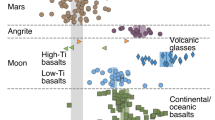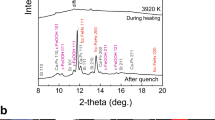Abstract
Knowledge of the composition of the Earth's core1,2,3 is important for understanding its melting point and therefore the temperature at the inner-core boundary and the temperature profile of the core and mantle. In addition, the partitioning of light elements between solid and liquid, as the outer core freezes at the inner-core boundary, is believed to drive compositional convection4, which in turn generates the Earth's magnetic field. It is generally accepted that the liquid outer core and the solid inner core consist mainly of iron1. The outer core, however, is also thought to contain a significant fraction of light elements, because its density—as deduced from seismological data and other measurements—is 6–10 per cent less than that estimated for pure liquid iron1,2,3. Similar evidence indicates a smaller but still appreciable fraction of light elements in the inner core5,6. The leading candidates for the light elements present in the core are sulphur, oxygen and silicon3. Here we obtain a constraint on core composition derived from ab initio calculation of the chemical potentials of light elements dissolved in solid and liquid iron. We present results for the case of sulphur, which provide strong evidence against the proposal that the outer core is close to being a binary iron–sulphur mixture7.
This is a preview of subscription content, access via your institution
Access options
Subscribe to this journal
Receive 51 print issues and online access
$199.00 per year
only $3.90 per issue
Buy this article
- Purchase on Springer Link
- Instant access to full article PDF
Prices may be subject to local taxes which are calculated during checkout
Similar content being viewed by others
References
Birch, F. Density and composition of mantle and core. J. Geophys. Res. 69, 4377–4388 (1964).
Ringwood, A. E. Composition of the core and implications for the origin of the Earth. Geochem. J. 11, 111–135 (1977).
Poirier, J. P. Light elements in the Earth's outer core: a critical review. Phys. Earth Planet. Inter. 85, 319–337 (1994).
Loper, D E. The gravitationally powered dynamo. Geophys. J. R. Astron. Soc. 54, 389–404 (1978).
Jephcoat, A. & Olson, P. Is the inner core of the Earth pure iron? Nature 325, 332–335 (1987).
Stixrude, L., Wasserman, E. & Cohen, R. E. Composition and temperature of the Earth's inner core. J. Geophys. Res. 102, 24729–24739 (1997).
Rama Murthy, V. & Hall, H. T. The chemical composition of the Earth's core: possibility of sulfur in the core. Phys. Earth Planet. Inter. 2, 276–282 (1970).
Atkins, P. W. Physical Chemistry Ch. 7 (Oxford University Press, 1994).
Boehler, R. Fe-FeS eutectic temperatures to 620 kbar. Phys. Earth Planet. Inter. 96, 181–186 (1996).
Masters, T. G. & Shearer, P. M. Summary of seismological constraints on the structure of the earth's core. J. Geophys. Res. 95, 21691–21695 (1990).
Alfè, D. & Gillan, M. J. First-principles simulation of liquid Fe-S under Earth's core conditions. Phys. Rev. B 58, 8248–8256 (1990).
Alfè, D., Price, G. D. & Gillan, M. J. Oxygen in the Earth's core: A first-principles study. Phys. Earth Planet. Inter. 110, 191–210 (1999).
Alfè, D., Kresse, G. & Gillan, M. J. Structure and dynamics of liquid iron under Earth's core conditions. Phys. Rev. B 61, 132–142 (2000).
Ahrens, T. J. Equations of state of iron sulfide and constraints on the sulfur content of the Earth. J. Geophys. Res. 84, 985–998 (1979).
de Wijs, G. A., Kresse, G. & Gillan, M. J. First-order phase transitions by first-principles free-energy calculations: The melting of A1. Phys. Rev. B 57, 8223–8334 (1998).
Alfè, D., Gillan, M. J. & Price, G. D. The melting curve of iron at the pressures of the Earth's core from ab initio calculations. Nature 401, 462–464 (1999).
Alfè, D., Gillan, M. J. & Price, G. D. Thermodynamics of hexagonal-close-packed iron under Earth's core conditions. Phys. Rev. B (submitted).
Alfè, D., de Wijs, G. A., Kresse, G. & Gillan, M. J. Recent developments in ab-initio thermodynamics. Int. J. Quant. Chem. 77, 871–879 (2000).
Giannozzi, P., de Gironcoli, S., Pavone, P. & Baroni, S. Ab initio calculations of phonon dispersions in semiconductors. Phys. Rev. B 43, 7231–7242 (1991).
Kresse, G., Furthmüller, J. & Hafner, J. Ab initio force-constant approach to phonon dispersion relations of diamond and graphite. Europhys. Lett. 32, 729–734 (1995).
Chandler, D. Introduction to Modern Statistical Mechanics (Oxford University Press, 1987).
Frenkel, D. & Smit, B. Understanding Molecular Simulation Ch. 4 (Academic, New York, 1987).
Sugino, O. & Car, R. Ab initio molecular dynamics study of first-order phase transitions: melting of silicon. Phys. Rev. Lett. 74, 1823–1826 (1995).
Kresse, G. & Furthmüller, J. Efficient iterative schemes for ab initio total-energy calculations using a plane-wave basis set. Phys. Rev. B 54, 11169–11186 (1996).
Voc̆adlo, L., Brodholt, J., Alfè, D., Price, G. D. & Gillan, M. J. The structure of iron under the conditions of the Earth's inner core. Geophys. Res. Lett. 26, 1231–1234 (1999).
Usselman, T. M. Experimental approach to the state of the core: part I. The liquidus relations of the Fe-rich portion of the Fe-Ni-S system from 30 to 100 kb. Am. J. Sci. 275, 278–290 (1975).
Hammond, B. L., Lester, W. A. Jr & Reynolds, P. J. Monte Carlo Methods in Ab Initio Quantum Chemistry (World Scientific, Singapore, 1994).
Rajagopal, G., Needs, R. J., James, A., Kenny, S. D. & Foulkes, W. M. C. Variational and diffusion quantum Monte Carlo calculations at nonzero wave vectors: Theory and applications to diamond-structure germanium. Phys. Rev. B 51, 10591–10600 (1995).
Kent, P. R. C. et al. Finite-size errors in quantum many-body simulations of extended systems. Phys. Rev. B 59, 1917–1929 (1999).
Kilburn, M. R. & Wood, B. J. Metal-silicate partitioning and the incompatibility of S and Si during core formation. Earth Planet. Sci. Lett. 152, 139–148 (1997).
Acknowledgements
The calculations were performed using the NERC-supported Cray T3E machines at the Manchester CSAR Centre and at the Edinburgh Parallel Computer Centre, and the UCL HiPerSPACE Centre. Support from the NERC and discussions with L. Voc̆adlo are acknowledged.
Author information
Authors and Affiliations
Corresponding author
Rights and permissions
About this article
Cite this article
Alfè, D., Gillan, M. & Price, G. Constraints on the composition of the Earth's core from ab initio calculations. Nature 405, 172–175 (2000). https://doi.org/10.1038/35012056
Received:
Accepted:
Issue Date:
DOI: https://doi.org/10.1038/35012056
This article is cited by
-
Electron work function – a probe for interfacial diagnosis
Scientific Reports (2017)
-
Possible thermal and chemical stabilization of body-centred-cubic iron in the Earth's core
Nature (2003)
Comments
By submitting a comment you agree to abide by our Terms and Community Guidelines. If you find something abusive or that does not comply with our terms or guidelines please flag it as inappropriate.



